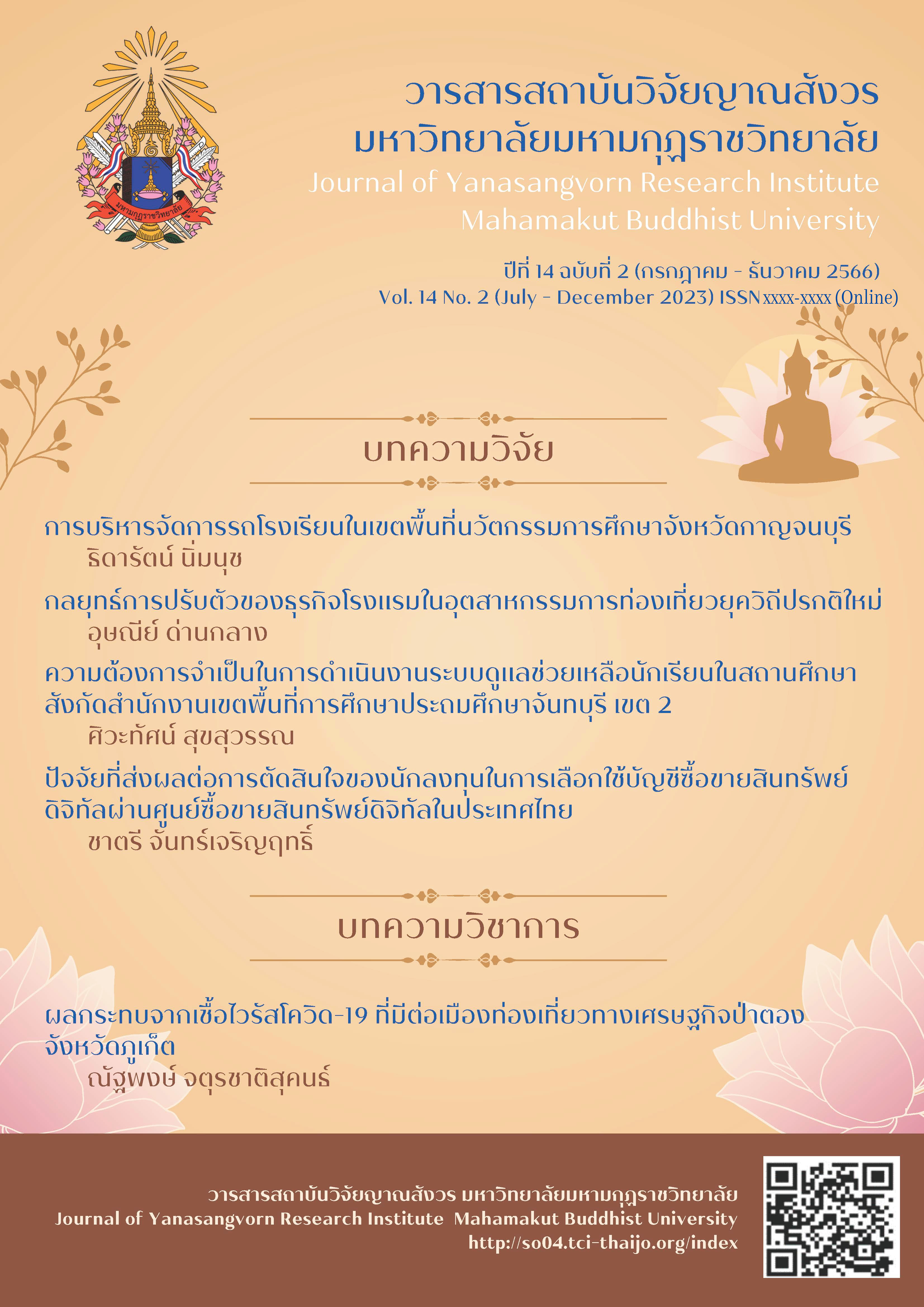THE CAUSAL RELATIONSHIP OF INNOVATION FACTORS AFFECTING THE PERFORMANCE OF SUPPORT PERSONNEL, CHIANG MAI RAJABHAT UNIVERSITY
Main Article Content
Abstract
This research is to study the causal relationship of innovation factors from routine work affecting the performance of support personnel of Chiang Mai Rajabhat University. Objectives are 1.To develop a causal relationship model between routine innovation factors affecting performance of support personnel of Chiang Mai Rajabhat University. 2.To examine the coherence of the causal relationship model between innovation factors from the routine work that affects the efficiency of the work of the support personnel of Chiang Mai Rajabhat University. The researcher has studied the concepts and theories related to the research as follows: innovation theory concept concepts, theories, operational efficiency, and related research. The sample group was academic support personnel of Chiang Mai Rajabhat University. The researcher determined the sample group from the formula for calculating the given sample group 20 times per 1 variable. In this study, there were 6 variables studied. Therefore, there should be a sample of 300people. The researcher used a proportional random sampling according to the type of support personnel classified by departments and used a questionnaire as an educational tool. The initial variable is 1.Innovation creation behavior of personnel 2.Transformational leadership 3. Innovation creating atmosphere 4.Learning culture 5. Corporate innovation support 6. Innovation creation. The dependent variable is operational efficiency. The preliminary data analysis used basic statistical values such as mean, standard deviation. The correlation coefficient between observable variables of causal relationship was analyzed using Pearson's correlation coefficient as data for model analysis. The researcher uses statistics, path analysis, and uses a software package for analysis Amos. The results showed that learning culture affects innovation the most, followed by the innovation behavior of personnel, transformational leadership, and lastly is the support of corporate innovation. All factors directly affect innovation and indirectly affect operational efficiency.
Article Details

This work is licensed under a Creative Commons Attribution-NonCommercial-NoDerivatives 4.0 International License.
References
จารุวรรณ เมืองเจริญ และประสพชัย พสุนนท์. (2562). การสร้างสรรค์นวัตกรรมกระบวนการทำงานที่มีต่อประสิทธิผลการปฏิบัติงานของพนักงานร้านสะดวกซื้อใน
เขตกรุงเทพมหานคร. วารสารเศรษฐศาสตร์และกลยุทธ์การจัดการ 6(2), 73-78.
นัฐกานต์ ฐิติจำเริญพร และ กัลยกิตติ์ กีรติอังกูร.(2561).ปัจจัยที่มีอิทธิพลต่อพฤติกรรมเชิงนวัตกรรมของพนักงานองค์การธุรกิจของ บริษัทโตโยต้า ไดฮัทสุ เอ็นจิ
เนียริ่ง แอนด์ แมนูแฟคเจอริ่ง จำกัด. Veridian E-journal, 11(2), 651-669.
นิตยา มั่นชำนาญ, สิทธิพร นิยมศรีสมศักดิ์, และ สุขุม มูลเมือง. (2555). รูปแบบการพัฒนาประสิทธิผลของโรงเรียนมัธยมศึกษาขนาดใหญ่ สังกัดสำนักงานคณะ
กรรมการการศึกษาขั้นพื้นฐาน, วารสารการบริหารการศึกษามหาวิทยาลัยบูรพา, 6(2), 31-44.
ปัญญา เลิศไกร, นิลรัตน์ นวกิจไพฑูรย์, ลัญจกร นิลกาญจน์,และ กฤตพร แซ่แง่ สายจันทร์. (2562).การจัดการนวัตกรรมการพัฒนาองค์กร, วารสารมหาจุฬานาครทร
รศน์, 6(8), 3745-3757.
สมบัติ นามบุรี. (2562). นวัตกรรมและการบริหารจัดการ, วารสารวิจัยวิชาการ, มหาวิทยาลัยรัตน บัณฑิตกรุงเทพฯ, 2 (2),121-134.
ศิวะนันท์ ศิวะพิทักษ์ . (2554). การจัดการนวัตกรรมขององค์กรธุรกิจที่มีผลต่อการสร้างสรรค์ นวัตกรรมของพนักงาน, หลักสูตรบริหารธุรกิจดุษฎีบัณฑิต, บัณฑิตวิทยาลัย, มหาวิทยาลัยธุรกิจบัณฑิต.
Amabile, T. M., Conti, R, Coon, Heather, C., Lazenby, J., & Herron, M. (1996). Assessing the work environment for creativity. Academy of
Management Journal, 39(5), 1154-1184.
Bass, B. M., & Avolio, B. J. (1996). The transformation and transactional leadership of men and woman. Applied Psychology: An International Reviews, 45(1), 5-35.
Boonyam, T., Chuawanlee, W., Supparerkchaisakul, N., & Anurit, P. (2011). The Multi-Level Causal Factors Influencing Individual and Group Innovative Behavior for MakingProduct Innovations in Thai Private Companies. Journal of Behavioral Science Vol, 17(2).
Boyett, J. H. (2006). Transformational leadership: The highly effective leader/ follower relationship. The Science of Leadership, 1-9.
De Jong, J. P., & Den Hartog, D. N. (2008). Innovative work behavior: Measurement and validation. EIM Business and Policy Research,
(1), 1-27.
Ekvall, G., & Ryhammar, L. (1999). The creative climate: Its determinants and effects at a Swedish university. Creativity research
journal,12(4), 303-310.
Hair, J. F., Black, W. C., Babin, B. J., & Anderson, R. E. (2014). Multivariate data analysis: Pearson new international edition. Essex: Pearson
Education Limited, 1(2).
Hoy, K. W., & Miskel, G., C. (2001). Educational administration: Theory, research, and Practice (6th ed.) Singapore: McGraw-Hill.
Janssen, O. (2000). Job demands, perceptions of effort-reward fairness and innovative work behavior, Journal of Occupational and
Organizational Psychology 73(3), 287 – 302.
Kaplan, R. S., & Norton, D. P. (1996). Strategic learning & the balanced scorecard. Strategy & Leadership, 24(5), 18-24.
Senge, P.M., Kleineer, A., Roberts, C., Roos, R. B. , & Smith, B.J. (1994). The fifth discipline fieldbook: Strategies and tools for building a
learning organization. New York: Doubleday Dell Publishing Group, Inc.
West, M. A., & Wallace, M. (1991). Innovation in health care teams. European Journal of social psychology, 21(4), 303-315.


